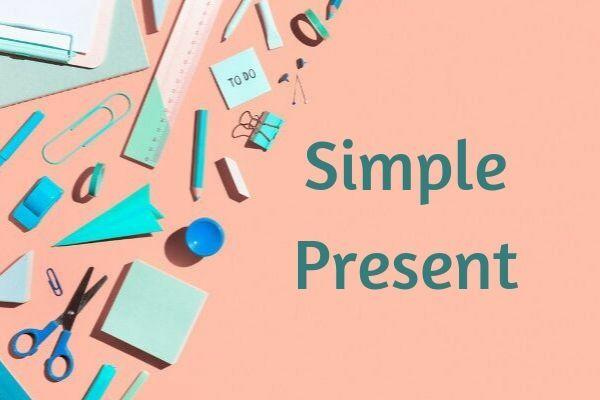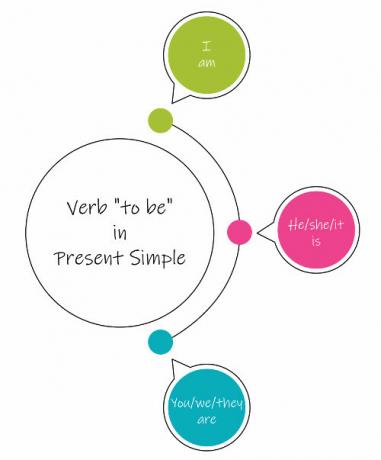We must use the tense simple presentto describe actions in general. We need to be careful when we think about actions that happen in speaking time, that is, as if they were happening now, as the actions in progress actually refer to another tense: the present continuous. That said, we can focus on the simple present, formed by the verb mainin the infinitive without the preposition to, when we talk about something that happens frequently.
Unlike the Portuguese language, in English, the verbs in simple present are not inflected at all people, except in the third person singular (he/ele, she/ela, it/he, she) |1| in affirmative sentences. Another peculiarity is the use of auxiliary verbs of and doesin interrogative and negative sentences. In the following topics, we will explain the use of this verb tense, approaching its structure and conjugating some verbs. Come on!

When to use the simple present?
→ What time do you have breakfast every day?
- What time do you eat breakfast each day?
→ Do you go to work by car or bicycle?
- Do you go to work by car or by bicycle?
Through the questions, we can see the interest in what we do in our daily lives. O simple present it is used precisely to describe what people do in everyday life. In addition, we can use it to portray facts or truths in general, characterize some states emotional or physical and personal characteristics, narrating or synthesizing stories or events, among others uses|2|. In the following table, we will explore in the examples each use we can make of the simple present:
(Daily routine, habits, customs) |
|
1- They always wake up at 7 am. (They always wake up at 7:00 am.) 2- Clear cereals for breakfast. (Clara eats cereal for breakfast.) 3- She doesn't study in the library on Mondays. (She doesn't study at the library on Mondays.) |
(Facts and general truths) |
|
1- The sun rises in the east. (The sun rises in the east.) 2- The water boils at 100 degree Celsius. (The water boils at 100 degrees Celsius.) |
(Emotional states, physical and personal characteristics) |
|
1- Denis is a happy person. (Denis is a happy person.) 2- He is tall. (He is tall.) 3- They don’t seem to be very comfortable. (They don't seem to be comfortable.) 4- Jack hates chocolate (Jack hates chocolate.) 5- Is Carlos a good teacher? (Is Carlos a good teacher?) |
(Narration or summary of stories or events) |
|
1- Ana goes to school after lunch. She studies in the afternoon. Then, she goes home with her friend and they study and play together. (Ana goes to school after lunch. She studies in the afternoon. Then she goes home with her friends and they study and play together.) 2- According to the author, this paper is very important to define the composition of modern bands in Brazil. He affirms that people really love to mix genres. (According to the author, this article is very important to define the composition of modern Brazilian bands. He claims that people really like to mix genres). |
Not to forget the different jobs of the simple present, how about you draw up a list, according to each use, with your own examples?!
See more: Simple past: tense that indicates an action from the past that has already been completed
Main rules of simple present
In this part of the text, we will look at the structured simple present in English, focusing on grammar rules. First, we emphasize that the sentence is composed of the subject + verb + complement:
I. I dance with you.
- (I dance with you.)
It is important to say that the syntactic order (of the words) follows a different rule from our language in interrogative sentences (you will see in the following topics). In addition, the conjugation of the main verb differs from Portuguese, since the verb it only changes in the third person singular: he (he), she (Is it over there), it (he/she), in the affirmative, facilitating – in a way – our learning regarding the conjugation of verbs.
Lastly, the english usesauxiliary verbs (of/does) in both negative and interrogative sentences. We'll cover each of these quirks separately in the following sections.
Affirmative form

Language has its devices to mark some aspects of time, person and place. We perceive in affirmative sentences the addition of -s to the main verb, indicating that it is the 3rd person singular (he, she, it). For example:
I. Alice goes to the gym.
- (Alice goes to the gym.)
II. It’s a beautiful day.
- (It's a beautiful day.)
The two examples present two other important aspects of affirmative sentences:
- Spelling rules for the 3rd person singular;
- Irregular verbs in simple present.
In the conjugation of the verb in the third person singular, there are spelling rules:
Most verbs: add –s. |
I feel (I feel) they live (They live) we talk (We talked) you read (You read) |
she feels he lives he talks she reads |
Verbs ending in –ss, –sh, –ch, –o, –x: add –es. |
we pass (We pass) they wash (They/they wash) you watch (you watch) I go (I will) I relax (I relax) |
he passes she washes It watches He goes she relaxes |
Verbs ending in a consonant + y: remove the –y and then add –ies. |
I study (I study) you copy (you copy) they cry (they/they cry) |
He studies she copies he creates |
Verbs ending in a vowel + y: –s are added. |
you play (you joke) they say (They/they say) |
He plays she says |
As for the conjugation of other people, the verb remains the same. For example: I/you/we/they read. (I read, you read/you read, we read, they/they read).
At the simplepresent, there are only two irregular verbs: the verb I'mwell(being/being) and I'mhave(to have). The conjugation is different. Check it out at the end of the text, at table with examples of conjugated verbs, their complete conjugation!
Negative form
In the negative form of the simple present,é need to use auxiliary verbof/does. As an auxiliary verb, that is, when it occupies a position in the sentence in order to signal that the sentence is negative, the auxiliary verb do/does has no semantic sense. But if it occupies the position of main verb in the sentence, its semantic sense is to do. For example:
I. I don’t (do not) speak Italian.
⇒ I don't speak Italian. (The verb of indicates that the phrase is negative. The main verb of this sentence is speak).
II. I of my Italian homework.
⇒ I do my Italian homework. (The verb ofoccupies the position of main verb. It has the sense of doing).
As we pointed out about the spelling aspects for the 3rd person singular, the helper of must also follow the same rules. So we must say:
I. she doare younot (of theare you not) have lunch at home.
⇒ She doesn't have lunch at home.
Interrogative form
To ask a question on simplepresent,we must use the auxiliary verbof/doesboth in the question and in the short answer. The auxiliary verb must always come at the beginning of the question. Furthermore, the auxiliary verb has no semantic meaning either, it only occupies a position in the sentence to indicate that we are facing a question in English. For example:
Question: Do you go out with your friends? / Do you go out with your friends?
The verb of indicates that the sentence is interrogative. The main verb of this sentence is go.
short answers (short answers) |
Complete answers (complete answers) |
|
Yes, I do. (Yes, I do.) or No, I don’t. (No, I don't go out.) |
Yes, I go out with my friends. (Yes, I go out with my friends.) or No, I don’t go out with my friends. (No, I don't go out with my friends.) |
If it's a question in the 3rd person singular, it is used does, for example:
Question: Does he study English at school? / Does he study English at school?
The auxiliary verb is does. The main verb of the sentence is study.
short answers (short answers) |
Complete answers (complete answers) |
|
Yes, he does. (Yes, he studies.) or No, he doesn’t. (No, he doesn't study.) |
Yes, he studies English at school. (Yes, he studies English at school.) or No, he doesn’t study English at school. (No, he doesn't study English at school.) |
Note that the verb at3rd person singular, both in the negative and in the interrogative phrase, you need the help does. Consequently, the main verb does not need to be marked with –s, –es or –ies (as in the affirmative), because the auxiliary verb already shows us that the subject of the sentence is in the third person.
Know more: Question words: what are they and how to use them
Table with examples of conjugated verbs
have (To have) |
go (Go) |
|||||
Affirmative |
negative |
interrogative |
Affirmative |
negative |
interrogative |
|
|
I (me) |
I have |
I dont have |
Do I have? |
I go |
I don’t go |
Do I go? |
|
you (you) |
you have |
you don’t have |
Do you have? |
you go |
you don’t go |
Do you go? |
He/she/it (he/she) |
he has |
He doesn’t have |
Does he have? |
she she goes |
she doesnt go |
Does she go? |
|
we (we) |
we have |
we don’t have |
do we have |
we go |
we don’t go |
Do we go? |
you (you) |
you have |
you don’t have |
Do you have? |
you go |
you don’t go |
Do you go? |
They (they) |
they have |
they don’t have |
Do they have? |
they go |
they don’t go |
Do they go? |
→ Don't forget that in English we can use the contracted form: don’t/doesn’t or complete: ofnot/doesnot.
readalso: Contracted forms: abbreviated forms in English
solved exercises
question 1
Highlight the correct alternatives:
Hi! My name am/is/are David and I am/is/are 25 years old. I live/lives in Sydney, Australia. I am/is/are a biologist and I work/works in a zoo with my sister Alice. She am/is/are 27 years old and she am/is/are a veterinarian. She help/helps the animals there. I go/goes to work at 7 am and she go/goes to work at 8 am. I don't/doesn't work on Saturdays and she don't/doesn't work on Sundays.
Resolution:
Hi! my name am/is/are (third person singular) David and I am/is/are (first person singular) 25 years old. I live/lives (first person singular) in Sydney, Australia. I am/is/are (first person singular) a biologist and I work/works (first person singular) in a zoo with my sister Alice. she she am /is/are (third person natural) 27 years old and she am/is/are (third person singular) a veterinarian. She help/helps (third person singular) the animals there. I go/goes (first person singular) to work at 7 am and she go/goes (third person singular) to work at 8 am. I don’t/doesn’t (first person singular) work on Saturdays and she don’t/doesn’t (third person singular) work on Sundays.
Grades
|1| “It” is a third person singular (he, she) subject pronoun to refer to objects, animals, situations, ideas, etc.
|2| Another use of simple present it's to talk about how often we do something.
By Patricia Veronica Moreira
English teacher
